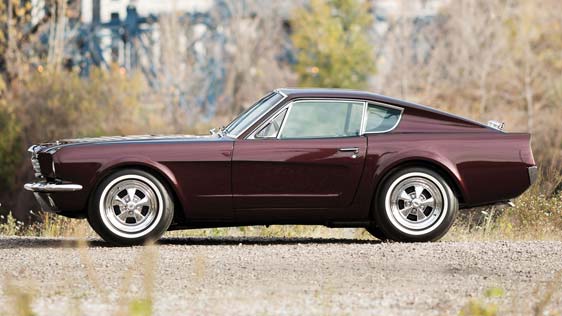This is the two-seat Mustang that Ford wanted to build
The Ford Mustang has never strayed from its original formula as a sporty four-seat coupe or convertible, despite evolving through myriad designs over its 52-plus year lifespan so far. Occasional concepts for two-seaters, however, have provided a curious sidebar to the pony car’s history, starting 18 months before the production Mustang arrived.
Ford debuted the Mustang name on a tiny two-seat, midengine sports car at the United States Grand Prix at Watkins Glen, N.Y., in October 1962. A running prototype, it succeeded at its mission of ginning up public interest in Ford’s Total Performance motorsports program and, by extension, possible showroom offshoots.
The little Mustang had no chance of production, but the public didn’t know that. Nor did the public know that Ford, the month before, had green-lighted development of a low-priced sporty four-seater based on the chassis of the Falcon econocar. Its final design had been locked down that summer, and Cougar and Torino were among names considered. By that November, it was called Mustang.
Even as customers were lining up to buy the new Mustang in the spring of 1964, Ford’s design department was looking at future possibilities. A photo dated April 23, just six days after the Mustang was introduced at the World’s Fair in New York, shows a clay model for a Mustang-themed two-seater.
That model went no further, but the two-seat idea resurfaced that autumn as an oddly proportioned coupe in the Ford Custom Car Caravan, which toured American auto shows to generate publicity. A “Mustang III” license plate linked the car to the earlier midengine roadster, which Ford had renamed Mustang I after introducing a lightly disguised preproduction model as the 1963 Mustang II concept car.
Ford had no intentions of building such a car, though, as a company representative told a potential customer, Bill Snyder, when he tried ordering one. Snyder and the Mustang III, however, would eventually reconnect.
Dearborn Steel Tubing, a fabricator of prototypes and special vehicles for Ford, built the Mustang III. As a foundation, Ford provided a Mustang convertible, the ninth of 15 preproduction prototypes made, but now with 16 inches snipped from its wheelbase, giving it the “shorty Mustang” nickname. The car’s V-8 was a prototype 302-cid version of Ford’s young small-block V-8.
A designer at the prototype company, Vince Gardner, created new fiberglass bodywork from the A-pillars rearward, including a short fastback roof that mimicked the production model. Any resemblance to the period’s altered-wheelbase drag-race machines cars was most likely unintended.
Gardner, who also helped build the car, became quite attached to his creation. When the Mustang III returned to its builder in the spring of 1965 with instructions that it be destroyed, he stole the car, stashing it in a warehouse and building a wall to hide it. Months later, when Gardner failed to pay rent, the landlord discovered the car and notified authorities.
Aetna Insurance paid the theft claim and sold the Mustang III to one of its executives, who four years later advertised it for sale in Hemmings Motor News. The buyer was Snyder, who’d tried to buy it years before. He had the oddball Mustang restored in 2013 and displayed it at the 2014 Ford Product Development Center Car Show as the “Mustang III Prototype.” At the 2015 Amelia Island Concours d’ Elegance the Mustang III caught the attention of car collector and historian Howard Kroplick, who said he’d never heard of the car before. He purchased it at the Auctions America sale in Fort Lauderdale, Fla., that month.
“Records show it was ‘commissioned by Ford,’” said Kroplick, president of the Long Island Motor Parkway Preservation Society. “But I wouldn’t say it was a Ford prototype. It was more of an idea car.”
Since the Mustang III was built from a pre-production prototype, many parts are stamped “XE” for Experimental Engineering or “XF” for Experimental Ford. Several parts of the car had tags stamped “Special Falcon,” and the glass was marked “prototype.” The car has a Falcon ignition key. Kroplick sees the car’s age as highly significant in Mustang history.
“This is the oldest Mustang on the road today,” he said. “Only the Mustang II show car is older.”
Ford revisited the two-seat theme in 1967 with the midengine Mach II, a functional prototype based on Mustang components and studied as a Cobra successor. Later, a two-seat mid-engine Boss 429 known as the LID Mustang – for Low Investment Drivetrain – used a stock Mustang body but was also dismissed.
To build buzz around the redesigned 1994 Mustang, Ford once again issued a two-seat show car, the Mach III, to preview the new design theme. Nearly a quarter-century later, the Mustang continues with its successful four-seat configuration.


